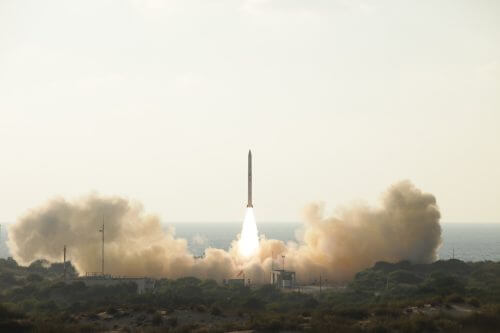So far, Israel has maintained a record of 100% success - every satellite that reached space performed properly and even beyond that

The military photography satellite Ofek 11 was launched into space in the afternoon from the Palmahim base on a Shavit 2 launcher. However, the joy of the successful launch was short-lived, when the satellite passed over Israel and contacted its operators, it seems that not all of its systems were working as planned.
The Ministry of Defense Spokesperson's Office said in response: "The Space Directorate at the Ministry of Defense and the Aerospace Industry launched the 'Ofek 17' observation satellite into space this evening at 40:11. The launch was carried out using a satellite launcher of the 'Shavit' type, from an experimental field in the center of the country. The satellite enters orbit around the Earth, contact is made with it and its systems are being tested. The engineers of the Space Directorate at Mpaat, together with the engineers of the aerospace industry, are continuing the series of tests that were planned in advance."
"The 'Ofek 11' satellite was developed based on the experience gained by the defense establishment in the development of previous satellites of the 'Ofek' series, which were launched into space starting in 1988.
After the observation satellite was launched, it entered its orbit, but when it was in the area of Israel, when contact was made with it and the systems were checked, several alerts were discovered that could indicate problems with the satellite. Ofer Doron, manager of a space plant in the aerospace industry, added that "there are some things that don't seem routine, but the process of deciphering the state of the satellite is ongoing." In the announcement of the Ministry of Defense, it was stated that "the engineers of the Space Directorate at Mpaat, together with the engineers of the aerospace industry, are continuing the series of tests that were planned in advance."
Just this week, the chairman of the Space Agency, Prof. Yitzhak Ben Israel, said at the meeting of the Knesset's science committee that dealt with the loss of the Amos 6 satellite on September 1, when the launcher on which it was stationed caught fire during refueling about two days before the planned launch, that Israel's satellite program should be separated which is an organized program, where every few years a satellite is launched and there are always satellites under construction, and the communication satellite program that depends on market forces.
Until now, Israel, and in particular the Aerospace Industry, the manufacturer of both types of satellites, has maintained a record according to which every satellite that managed to reach space, operated successfully, sometimes even beyond the time it was planned for. The Israeli space community hopes that in the end they will be able to stabilize Ofek 11, and maintain the record. In any case, Israel's possibility to observe directly and legally what is happening in hostile countries with independent tools will be preserved.
About two years ago, the Ofek 10 satellite was launched, which, unlike the other Ofeks, was a radar satellite that allows photographs in any weather and at night. The media reported that Ofek 11 is an optical satellite with improved capabilities compared to previous generations, but its resolution was not disclosed.

5 תגובות
Launching a geostationary communication satellite requires a launch to the east, and if launched from the Palmyra, it may come out over quite a few Israeli settlements, not to mention other Arab countries, which may not be very pleased with the risk of the missile falling on Rabat Ammon or Baghdad, for example. And that's before we started discussing the comet's ability to carry Amos.
I think it's a scandal that they didn't start in the first place to prepare a backup plan for sending another satellite. Even before the launch, they already managed to sell all the bandwidth to Facebook, that is, there is demand. Even if they launched Amos 6B he probably wouldn't be unemployed in the sky. But if this stupid country is going to let the "Space" company be sold to the Chinese - who cares?
A communication satellite weighs about 5 and a half tons. Photo satellite about a tenth. Hence, a rocket about 10 times larger is required to launch a communication satellite. Price and the closing of a safety zone and also the fact that Israel is the only country that sends to the West for reasons of good neighborliness mean that it is not economical to do so.
A comet launcher is capable of launching a payload of between 290-550 kg (according to various publications, the exact number is not officially known) to a low orbit, approximately 500 km above the earth, which is the height a spy satellite needs.
On the other hand, a satellite like Amos 6 weighed about 5 tons, and is designed to stay at an altitude of about 36,000 km (called a geostationary orbit), at this altitude, for an observer from Earth, the satellite always remains in the same place, so that the antennas can be aimed once And they will always receive the satellite.
A comet launcher is not capable of launching such weights and to such heights, so you have to use the services of companies like spaceX that offer launches to much greater weights and heights.
I guess it's a question of weight.
A weight that does not exceed 350 kg can be launched from Falmahim (a launch from Falmahim is made towards the west in a very narrow vector unlike the other launches in the world which are launched towards the east. This is to prevent the possibility of technology falling to Arab countries).
Amos shekel 5.5 tons.
a question :
Why aren't Amos satellites also launched from Israel on a Shavit 2 launcher?